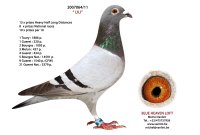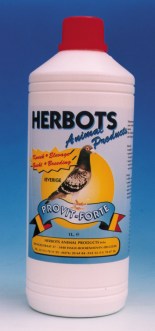As we promised in our previous article, we bring you the complete report of a recent publication. It’s our intention that everything becomes more clear about the always returning problem of the respiration of our pigeons and the herpes virus involved.
“The respiration takes care of the gas exchange; inhaling oxygen and breathing out carbon dioxide and hereby it’s one of the most important aspects of their sportive results. So it’s logical that the respiration problem is one of the most important causes of bad results of our pigeons. A pigeon in good health has a pink throat, without slimes and the lowest edge of the soft palate is split by a thin crack. The backside of the throat also has to be pink, without infection and the veins may not be swollen. The palate crack, which is the entrance to the nose has to be “dentated” thinly and without slimes. These are opened a bit so the air can pass easily for the oxygenation of the lungs. The eye of a pigeon in good health shines strongly and is surrounded by a white and dry edge and of course a strong coloured iris.
 |
"LILI", the favorite for 2013
of "BLUE HEAVEN LOFT" |
Clinical aspects of respiration problems: some affected pigeons start to sneeze and/or start to scratch their nose. The nose isn’t white any longer and it gets grey. The edge of the eye becomes yellow and moist. The nose wholes are closed and the bird has to open its beak to get some air. With a strong runny nose, this comes through the palate crack into the beak where it forms yellow membranes. In general, you can notice congestion in the back part of the palate where ulcers appear. In some cases, the opening of the larynx moves with jerks together with a rattle. This type of respiration problem can easily be noticed by the fancier and we call it wet snot. A form that isn’t that visible but also appears frequently is the dry snot. With this type, the pigeon has no runny nose, the nose will remain white but the bird starts to sneeze when we push the nose. The tear canal is all stuffed up and the edges of the eyes are moist. This type of respiration infection can only be found by a good research. The results are bad, certainly with high temperatures and wind at the head. In this kind of weather conditions, some pigeons come back home with severe respiration problems and this can be seen by the typical aspect, which we call “thick heads”. This form of respiration problems can be very dangerous for the youngsters. When they suffer from this, the lost will be very high. In contrast with some authors, we’re sure that health is very important when we talk about the great lost with our youngsters.
The Herpes virus with our pigeons:
The Herpes virus has been indicated with pigeons with respiration problems, for the first time in 1967. Scientifically they showed that the this virus is very important when the pigeons have respiration problems. This virus is spread all over the world. The vaccination of this pathogen agent, allows to cultivate this disease for experiment. In case of serious respiration problems, this herpes virus can be isolated in the throat with 80% of the pigeons. The different forms of respiration problems, which we mentioned, can be explained by the germs that complicate the infection with the herpes. The herpes virus is the very important with respiration problems and multiplication of the virus in the cells of the throat of the pigeon often comes together with respiration problems. But the present microbes and the cancer, take their profit out of this infection to multiply and the symptoms become worse. With the pigeons we can notice an infection of their throat, sinusitis and pneumonia. When the “airbags” get infected, the side will become thicker and it will become less elastic. The airbags can get filled with slime and pus that looks like cheese and hereby their function can change strongly. These wounds can remain after healing and the sportive career can be in danger. Without medical intervention, it frequently happens that the respiration problems caused by the herpes virus, will be transformed into a serious respiration problem when it gets hard to breath. The treatment is based on antibiotics even if antibiotics are in-active against the herpes virus. They allow to start a battle against the complicating microbes. The antibiotic will be chosen in function of the present microbes. Some, like mycoplasma en chlamydia were already described in previous articles. That’s why, according to us (The Lost Son), the bacteriological research has become a must to all that want to be sure.
The bacteriological research of the throat of the pigeons, also allows to isolate the complicating bacteria like: staphylococs, streptococs, pasteurella, colibacillea.
The last few years, they found a new bacteria; Riemellera columbina, and also associated with respiration problems with the pigeon. Also Pelistegia europaea can be isolated with tracheitis (infection of the trachea) and pneumonia with the pigeon.
A laboratory cultivation of these complicated bacteria, allows to realise an antibiogram and to find the adequate antibiotic for an effective treatment. This is very important because the infective bacteria become more and more resistant against the antibiotics we use now. So it’s important to respect the dose and the period we use it. Indeed, a treatment with a lower dose in too short a time (as it often is done with the preventive cures), this phenomenon will become worse in resistance. (read for you in “Duifke Lacht”, written by Dr. Jean Pierre Duchatel and Dr. Ferdy Vandersanden.) “
 |
Indispensable during
the breeding period |
Those who closely read the publication above, will surely understand better how important the respiration is to our feathered friends. And if we succeeded we can easily say: “mission accomplished”.
BLUE HEAVEN LOFT :
The breed evolves slowly but certainly positive. At the moment, the pigeons have little youngsters (January 19th 2013). Even with the low temperatures below zero, we don’t notice any problems. With the old hens of 7 and 9 years old, we didn’t move the eggs. We didn’t do out of respect and we appreciate what they produced the previous years. During the brood period, we cured them for 5 days with a product of our vet Raf Herbots and a few days later he came to vaccinate all breeders and feeders with Colombovac PMV/POX. We do this every year. To us it’s an important job because it gives us a good and certain feeling.
We’ve already prepared a text of our visit to Hungary, Boedapest,(January 11-13th 2013) where we were invited and participated to the celebration of the 57th National Exposition of the Hungarian Federation. But we will publish this together with the report of our visit to the Olympiad in Slovakia, January 25-27th 2013. In the mean time, stay warm and in good health.
Your servant
THE LOST SON
 |
| The Hungarian parliament at the blue Danube. |

|




